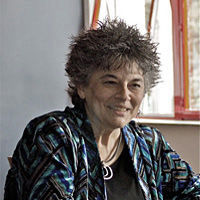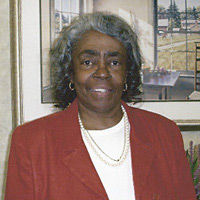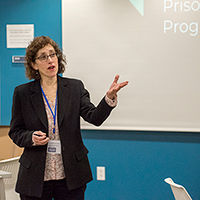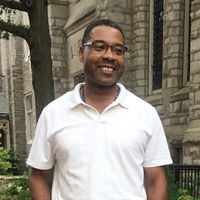
The Inside-Out Prison Exchange Program
The Inside-Out Prison Exchange Program® is an educational program with an innovative pedagogical approach tailored to facilitate dialogue across difference. It originated as a means of bringing together campus-based students with incarcerated students for a semester-long course held in a prison, jail or other correctional setting. While those core Inside-Out Prison Exchange courses have been replicated across the United States and in multiple countries since its inception in 1997, the program has expanded into a variety of other forms of educational and community-based programming. It also has grown into an international network of trained faculty, students, alumni, think tanks, higher education and correctional administrators, and other stakeholders actively engaged with, and deeply committed to, social justice issues.
The Inside-Out Praxis
The Inside-Out praxis is grounded in the belief that our society is strengthened when higher education/learning is made widely accessible and, at the same time, when it allows participants to encounter each other as equals, often across profound social barriers. The practice of bringing incarcerated (inside) and non-incarcerated (outside) people together for engaged and informed dialogue allows for transformative learning experiences that invite participants to take leadership in addressing crime, justice, and other issues of social concern. The Inside-Out pedagogy and methodology create these collaborative, creative contexts.
The Inside-Out Center
The Inside-Out Center is the international administrative office of The Inside-Out Prison Exchange Program® and is located on the main campus of Temple University in Philadelphia, Pennsylvania.
- Serves as the focal point for maintaining, growing, and disseminating the program’s mission, vision, values, and methodology.
- Provides the administrative nucleus for the program’s activities.
- Designs and runs The International Inside-Out Instructor Training Institute.
- Trains Think Tanks, composed of inside and outside alumni, to co-facilitate the Training Institute.
- Collects data from the network to support existing programming and strategically expand it.
- Provides support for trained faculty, serves as a resource, information clearinghouse and networking source for stakeholders.
- Maintains the Inside-Out website and online portal for trained instructor resources.
- Creates training manuals for replicating the program.
- Handles all national and international media coverage.
The Center is headed by the Founder and Executive Director, Lori Pompa, a faculty member of the Criminal Justice Department in the College of Liberal Arts at Temple University. The Inside-Out Center is guided by a Leadership Team composed of trained instructors in our network and they comprise two advisory bodies.
The Story of Inside-Out
In 1995, Lori Pompa, a professor in the Criminal Justice Department at Temple University, took a group of 15 undergraduate students to the State Correctional Institution at Dallas, PA for a tour of the facility. Here’s what happened next...
In 1995, Lori Pompa, a professor in the Criminal Justice Department at Temple University, took a group of 15 undergraduate students to the State Correctional Institution at Dallas, PA for a tour of the facility. Here’s what happened next.
As part of the tour, Lori and her students met with a panel of men who were incarcerated there, most of whom were serving life sentences. During the panel discussion, they touched on a variety of issues – social, economic, political, racial, psychological, philosophical – as they related to crime and justice. After this engaging, hour-long conversation, the time was up, but no one wanted to leave.
As Lori and her students were about to depart, a panelist named Paul approached Lori, suggesting that the conversation could be expanded over the course of a semester. It could, essentially, be a semester-long course where incarcerated and non-incarcerated students would read the same assignments, write papers, and engage in discussion together each week. Lori told Paul that it was an intriguing idea and promised him that she would consider it. However, she knew that the logistics of bringing students on a weekly basis to a facility 120 miles away from Philadelphia were far too challenging.
Yet, in the days after her visit to Dallas, Lori couldn’t stop thinking about Paul’s suggestion. She began to strategize ways to make this program work at a correctional facility closer to the university. Lori approached the Philadelphia Prison System and, in 1997, began teaching a course entitled “The Inside-Out Prison Exchange Program: Exploring Issues of Crime and Justice behind the Walls.” Paul’s idea was put into practice and The Inside-Out Prison Exchange Program® was born.
In 2000, other Temple faculty joined Lori in teaching Inside-Out courses and two years later, The Inside-Out Prison Exchange Program® expanded to Graterford Prison (now SCI-Phoenix), a state correctional facility an hour outside of Philadelphia. By pure coincidence, Paul had been transferred to Graterford and was able to take the first Inside-Out course offered there, which Lori taught. When that course ended, the inside and outside students decided to continue meeting, conversing, and working to raise public awareness about issues of crime, justice, and mass incarceration. Thus, the Graterford Think Tank was initiated, which began holding public workshops, extending the Inside-Out dialogic learning experience to an audience beyond college students.
Having been awarded a Soros Justice Senior Fellowship, Lori was able to begin working with a team of people, including inside and outside alumni, to develop replication criteria and materials for expanding the program across the country. In July 2004, the Graterford Think Tank hosted the inaugural instructor training, launching the first of now 79 Inside-Out Training Institutes, which have equipped over 1,200 college/university professors (and other educators) from around the world to teach Inside-Out courses.
An idea conceived in a prison classroom 25 years ago has now grown into an international movement comprised of more than 200 correctional and higher education partnerships, 1,200+ trained instructors, over two dozen tanks, and more than 60,000 students worldwide who have benefited from these life-changing courses.




